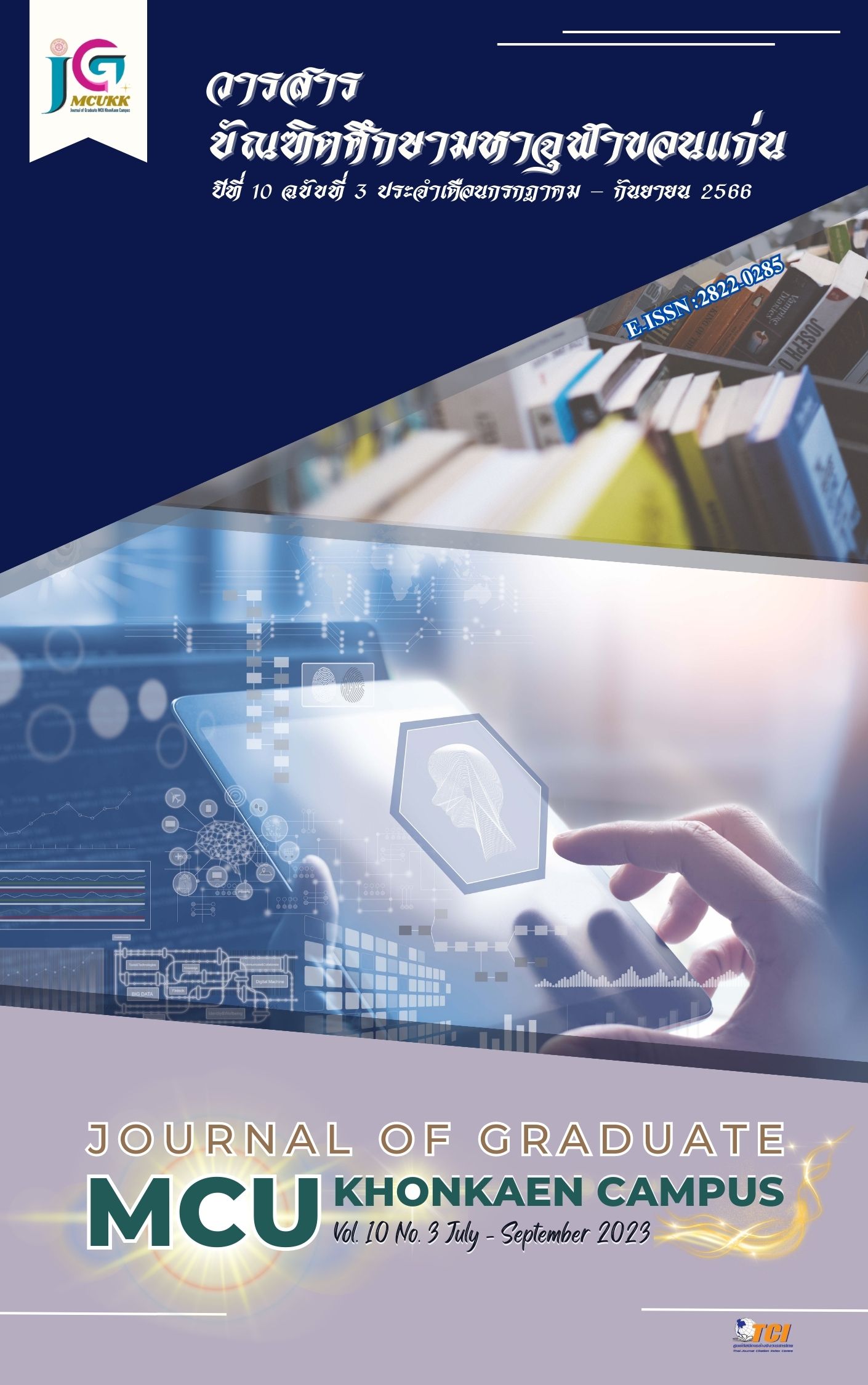Community Enterprise Development in Small SME Entrepreneurship Using the PLC process, the community of professional learning at BuengPhra District, Phitsanulok Province
Main Article Content
Abstract
The research results found that
1. Management and level of participation in the management of community enterprise groups of the community found that 1) Social capital: creating participation of people in the community leads to the greatest success in community development, followed by the joint use of social capital.
2) The most creative marketing is creating products that are unique to the local area. And the least is product development and design. Using the creativity of people in the community 3) The greatest potential of social networks is creating a good attitude towards joining social networks and having networks with shared morale and intentions. And the least is the cooperation of various networks, which affects the success of community organizations. 4) The highest development process is creating a participatory process for working together. And the least is a survey of social capital. and community resources Suggestions are listened to. and community needs
2. Level of problems and participation in community enterprise development Production problems of herbal community enterprises were found, namely lack of raw materials and lack of modern production tools. and do not have the skills to produce raw materials used in production are of inconsistent quality
3. Factors affecting the development of community enterprise groups Using the PLC process, professional learning communities are developing promotional projects and expanding distribution channels for community enterprise products. Procurement of modern machinery Establish a center for testing and certifying product quality standards. Developing community enterprise networks towards sustainability Strengthening new community enterprise entrepreneurs Organizing an exhibition of herbal community enterprise products, Bueng Phra Subdistrict, Mueang District, Phitsanulok Province
Article Details

This work is licensed under a Creative Commons Attribution-NonCommercial-NoDerivatives 4.0 International License.
References
กาญจนา แก้วเทพ. (2551). เอกสารการสอนชุดวิชา การสื่อสารกับการพัฒนา. (พิมพ์ครั้งที่ 6). กรุงเทพฯ: มหาวิทยาลัยสุโขทัยธรรมาธิราช.
ขวัญเชิญ ภาคฐิน. (2546). ปัจจัยที่มีความสัมพันธ์ต่อความสำเร็จของการประกอบการอุตสาหกรรมอาหารขนาดกลางและขนาดย่อม. (วิทยานิพนธ์ศิลปศาสตรมหาบัณฑิต). กรุงเทพฯ: มหาวิทยาลัยเกษตรศาสตร์.
เจษฎาภรณ์ บุญรัตถพันธ์. (2561). ภาวะผู้นำ. สืบคันเมื่อ 29 สิงหาคม 2561, จาก https://www.gotoknow.org/posts/389367
ชัยอนันต์ สมุทวณิช. (2527). ระบบราชการกับการมีส่วนร่วมของชุมชน : พิจารณาในแง่มหภาคในการมีส่วนร่วมของประชาชนในการพัฒนา. กรุงเทพฯ: ศูนย์ศึกษานโยบายสาธารณสุขมหาวิทยาลัยมหิดล.
ณพศิษฎ์ จักรพิทักษ์. (2552). ทฤษฏีการจัดการความรู้. กรุงเทพฯ: บริษัท ธนาเพรส จำกัด.
ณรงค์ฤทธิ์ อินทนาม. (2553). การพัฒนาหลักเทียบสำหรับการสร้างชุมชนการเรียนรู้ทางวิชาชีพในโรงเรียน. (วิทยานิพนธ์ครุศาสตรดุษฎีบัณฑิต). กรุงเทพฯ: จุฬาลงกรณ์มหาวิทยาลัย.
ดวงเดือน สมวัฒนศักดิ์. (2548). เอกสารวิชาการเรื่องวิสาหกิจชุมชน.สำนักส่งเสริมและพัฒนาการเกษตร เขตที่ 1. ชัยนาท: กรมส่งเสริมการเกษตร.
ทิพวรรณ หล่อสุวรรณรัตน์. (2548). ระบบสารสนเทศเพื่อการจัดการ Management Information Systems. กรุงเทพฯ: สถาบันบัณฑิตพัฒนบริหารศาสตร์.
วรลักษณ์ ชูกำเนิด และคณะ. (2557). รูปแบบชุมชนการเรียนรู้ทางวิชาชีพครูสู่การเรียนรู้ในศตวรรษที่ 21 บริบทโรงเรียนในประเทศไทย. วารสารหาดใหญ่วิชาการ, 12(2), 123-134.
สมแก้ว รุ่งเลิศเกรียงไร และคณะ. (2550). คุณลักษณะผู้ประกอบการที่ประสบความสำเร็จในภาคใต้ภาคอุตสาหกรรม. วารสารเศรษฐศาสตร์และบริหารธุรกิจ มหาวิทยาลัยทักษิณ, 2(1), 25-35.
สำนักงานคณะกรรมการพัฒนาการเศรษฐกิจและสังคมแห่งชาติ. (2560). แผนพัฒนาเศรษฐกิจและสังคม แห่งชาติ ฉบับที่ 12 (พ.ศ.2560 - 2564). กรุงเทพฯ: สำนักนายกรัฐมนตรี.
อุมาพร กาญจนคลอด. (2550). บทบาทหน่วยงานภาครัฐในการสนับสนุนวิสาหกิจชุมชนในจังหวัดนครศรีธรรมราช. (วิทยานิพนธ์รัฐประศาสนศาสตรมหาบัณฑิต). สงขลา: มหาวิทยาลัยสงขลานครินทร์.
Argyris and Schon. (1978). Organizational learning: A theory of action perspective. Reading. MA: Addison-Wesley.
insecurity. (2003). New York: Teachers College Press.
Kotter. J. P. & Cohen. (2002). The heart of change: Real-life stories of how people change their organizations. Boston: Harvard Business School Press.
Little. J. W. (1997). Excellence in professional development and professional community. Washington. D.C.: Office of Educational Research and Improvement.
Louis. K. S.. & Kruse. S. D.. (1995). Professional and community: Perspectives on reforming urban schools. Thousand Oaks. CA: Corwin Press.
Melanie. A. Apel,. (2000).Careers in Information Technology. New York: The Rosen Publishing Group. Inc.
Michael Polanyi and Ikujiro Nonaka. แนวคิด KM ของ Michael Polanyi และ Ikujiro Nonaka. สืบคันเมื่อ 29 กรกฎาคม 2563, จาก https://www.nstda.or.th/home/knowledge_post/km-michael polanyi-ikujiro-nonaka
Paul Bredeson. (2003). The APC Summer Institute. 2003 : A two-day workshop with Professor Paul Bredeson.University of Wisconsin – Madison.
Reichstetter. R. Defining a Professional Learning Community a Lliterature Review. E and R Report. Wake Country, 20.
